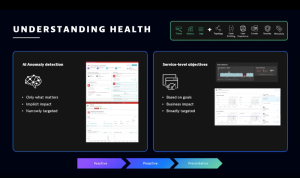As IT ecosystems become more complex, organizations struggle to monitor and maintain application health. That's why application resilience is more critical than ever.
Application resilience is a top priority for organizations in every industry. Even in higher education, IT staff depend on key visibility into their complex ecosystems of applications and infrastructure to monitor and manage application health.
At Perform 2023, Balint Kelen, product manager at Dynatrace, and the IT service owner and manager at a major American university, discussed the challenges of monitoring and maintaining the health of complex IT environments. They also explored how Dynatrace is advancing visibility and health monitoring with new AI-driven health view features.
Complex IT ecosystems bring application resilience challenges
As a major university, the school supports medical and research facilities, power stations, more than a dozen libraries, and multiple museums — all on top of thousands of students, faculty, and staff. For the university’s IT environment, this means hundreds of applications to manage — 50 of which are critical to daily function at the institution.
Recently, the university adopted Dynatrace to help monitor its applications. “We have Dynatrace, but it didn’t start there,” the university’s IT manager said. “In 2019, we actually recognized a few gaps in our previous monitoring solution.”
One major gap was application health. But for the university, as with many other organizations, issues aren’t one-dimensional. For example, most monitoring solutions are deployed piecemeal or simply don’t support integration with other critical systems. This fragmented approach limits tracking capabilities to siloed environments. Additionally, executive-level dashboards are often hard to create and maintain, leaving stakeholders with challenging upfront and long-term labor costs.
“They don’t want to see the details. They want to see that services are fine, the applications supporting them are good, [and] the rest of it is [the IT staff’s] responsibility,” the university’s IT manager said.
Application health monitoring tailored for every need
Dynatrace already provides customers with wide views of large IT ecosystems. But a simple status update can be hard to provide for a non-IT pro, like many folks in C-level positions who aren’t familiar with the details of application resilience. Because Dynatrace provides such a comprehensive monitoring system, a dashboard filled with detailed monitoring data isn’t useful for many higher-level stakeholders.

At the same time, “even though you can’t have everyone looking at dashboards all day, you still want dashboards. And certain stakeholders really want to see dashboards,” the university’s IT manager says. “In fact, they want to see if it’s green.”
By using Dynatrace, the university and other institutions aren’t eliminating the need for detailed monitoring dashboards. Instead, they’re adopting solutions that fit a wider range of stakeholder needs — and the dashboard is as granular or as high-level as the user needs it to be.
Application resilience made easy
To meet that need, the Dynatrace Health View is designed to help customers observe the overall application health while still retaining a basic view of app interconnectivity within the organization. A more detailed version of this is already present in the Dynatrace dashboard under the graph view, which shows a complex web of application connections.
Health View is an executive-level visual that depicts relationships among applications and their health using a simplified red, yellow, and green color labeling system. This provides a clear system status without overcomplicating the answer to the simple yet important question, “Is it fine?”
For stakeholders wanting to dig deeper into application health, clicking a node brings up new metrics and information, such as ownership and service-level objectives. Even in these deeper looks, Dynatrace makes sure the information stays relevant and readable.
“We have a lot of information, and it’s good, but you don’t always need it,” Kelen said. “So, progressive disclosure is something we have adhered to very strongly here. We give you the right information at the right time, in the right context.”
With this design philosophy, Dynatrace makes sure no stakeholders are left behind in the monitoring process.
To learn more about the executive-level health views, check out the full session, “Instantly understand and improve application health with new AI-powered analysis views.”





Looking for answers?
Start a new discussion or ask for help in our Q&A forum.
Go to forum